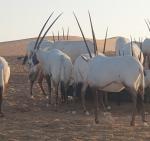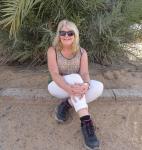My Nonprofit Reviews

ElaineW
Review for Biosphere Expeditions, Marina Del Rey, CA, USA
From Sand Dunes to Skyscrapers
What comes to mind when you think of Dubai? Shiny high rise hotels or extravagant shopping malls with giant aquariums? Perhaps the tallest building in the world, the Burj Khalifa, or palm shaped man made islands reclaimed from the sea. But there is another side to the story of Dubai and I travelled to the Dubai Desert Conservation Reserve (DDCR) with Biosphere Expeditions to discover more about it.
The DDCR is committed to re wilding a huge desert area of over 225 square kilometres which represents 5% of Dubai’s land mass. The reserve safeguards the stunning desert landscape with its dramatic dunes, gravel plains and rocky areas and has a provided a vital habitat for Dubai’s native species, many of which had become extinct in the wild. More than twenty years on from its creation by the ruler of Dubai - Sheik Mohammed bin Rashid Al Maktoum - the reserve is now home to hundreds of Oryx, the majestic national animal of the UAE. In fact this is now the largest free roaming herd in the emirates...
In addition there are about 300 elegant Arabian gazelles and 100 Sand gazelles. Other species include Arabian red foxes, hares, the Ethiopian hedgehog and some nocturnal rodents like Cheesman’s Gerbil. There are dozens of birds here too, including the endangered lap-faced vulture and the Pharaoh Eagle Owl. Lizards, snakes and scorpions also call the DDCR home.
On arrival we are given a tour of the brand new visitor centre which is really well done and a great introduction the reserve. From there we make our way to the conservation office to meet our scientists Maria and Basil. We learn about the equipment we will be using in the field. GPS trackers, compasses, datasheets and the all important binoculars (best to bring your own.)
We are then introduced to our camp, a small tented settlement close to the boundary of the reserve. There are basic toilets and showers and a kitchen, but the emphasis here is on the animals and not the people. This is no luxury holiday, you are here to work!
The whole reserve is divided into over 60 quadrats, and we are briefed the night before about where we are going the next day. We head out in our four wheel drive vehicles, after deflating the tyres and taking a ‘driving on sand roads’ test, which was actually rather good fun.
When we reach our destination, we observe from every angle for 30 minutes and record the type and number of species we see. Some of the time we are bird counting or looking for signs of the Pharaoh Eagle Owl which has been spotted in this reserve.
Our assignments take us out across the landscape to experience this stunning desert environment. There’s no spectacle quite like a glorious desert sunrise or the early morning mist snaking through the sand dunes like a silk scarf, before it burns off for the day.
This trip is in January so it’s not too hot in the day, but you do need to be prepared to walk a few kilometres and scale a substantial sand dune or two to reach your observation point. It’s also cold at night in the desert, so be prepared.
My companions, on this trip were from the UK, Germany and Italy and a nicer bunch of people I have yet to meet. A highlight for me was spotting a beautiful Arabian fox trotting along a sandy track in the far South of the reserve.
Malika, our Biosphere expedition leader said “It’s really important that we support the efficient management of the reserve and the animals seem to be thriving. The citizen science element of the trip is crucial because there are two scientists working in an area of about 225 square kilometres and there is a lot of wildlife out there. Doing a yearly inventory is an impossible thing for them to do; they need more eyes and ears out in the field to count animals and record data. We set the activities and the field science that we want teams to help us with, in a way that it’s like collecting stamps. You don’t have to be a biologist to collect data.”
Chris, one of the participants on the trip added “when you’re travelling it’s very easy to see lots of sights but it’s very rare that you actually get to contribute to the places that you are visiting, and with Biosphere you actually get to be a part of a scientific expedition collecting real data that helps to protect the ecosystem that you’re spending time in. What looked like just desert when you’re flying into Dubai airport comes to life and you get a very different perspective on things. You get to roll up your sleeves and make a difference.”
I took my leave of the desert and its delightful wildlife, with reluctance. I am heading for the vibrant metropolis of rapidly expanding Dubai city, so close to this precious re wilded place.
In just one hour I am transported to another world where high rise buildings are growing like a forest with the unfettered energy of this extraordinary city. Dubai's expansion is a testament to human ingenuity and ambition. Skyscrapers pierce the sky, luxury hotels redefine opulence, and city lights create a dazzling spectacle. Dubai is a story still being written at an incredible pace. Let’s hope the desert and its wildlife remain as a key chapter in that story.




